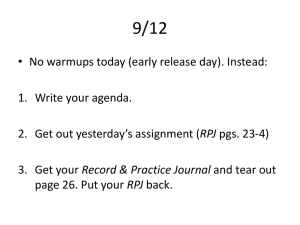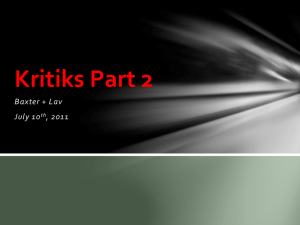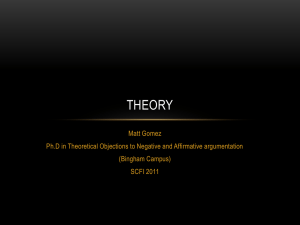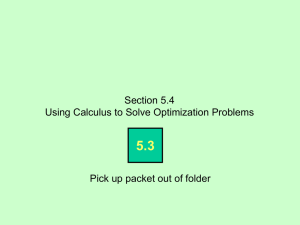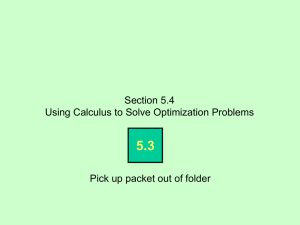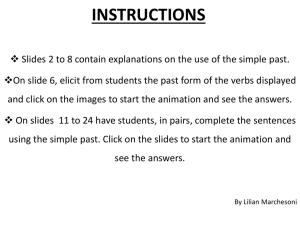Renal Pathology Lab November 7, 2013
advertisement
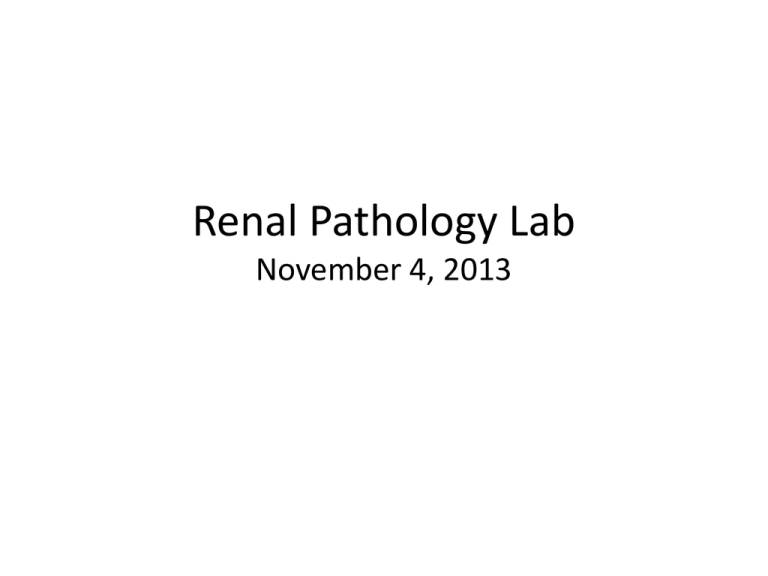
Renal Pathology Lab November 4, 2013 Renal Pathology Lab Case 1 • CHIEF COMPLAINT: “My back hurts.” • HISTORY: A 32-year-old woman presents to the emergency department with acute onset of fever, chills, and right flank pain. • She has also had nausea and vomiting and has been unable to keep any food down for the last day. • On further questioning she notes that she developed dysuria and urinary frequency several days prior. • PHYSICAL EXAMINATION: • Temp 102.10 F, BP 92/56, P 112 • Lungs and heart exams are normal, aside from tachycardia. • On abdominal exam there is suprapubic tenderness to palpation. • There is marked tenderness at the right costovertebral angle. UA w/Micro • • • • • • • • • • • • • • Color pH Spec Gravity Protein Blood Glucose Ketones Bilirubin Urobilinogen Nitrate Leukocyte esterase RBC WBC WBC casts Amber 6.0 1.030 Neg Trace Neg NEG NEG 0.2 POS POS 2-5 >150 few [YELLOW] [4.5-8.0] [1.003-1.035] [NEG] [NEG] [NEG] [NEG] [NEG] [0.2-1.0] eu/dl [NEG] [NEG] [0-2] /hpf [0-5] /hpf Q1. What is your clinical diagnosis? What is your rationale? Be sure to interpret the findings on urinalysis. Low power 20x 40x Q2. Identify the Organ Q3. Describe the histologic findings on the 20x image Q4. Describe the histologic findings on the 40x image. Be sure to name the structure to which the arrows are pointing. Identified on Urine Microscopy Q5. Describe the urine microscopy image. Correlate this with the histologic findings. Q6. Do the histologic findings support your clinical diagnosis? Q7. List complications that could develop as a result of this patient’s diagnosis. Renal Pathology Lab Case 2 • CHIEF COMPLAINT: “I’m having pain in my side for the past months.” • HISTORY: A 63-year-old male presents with right flank pain that has been ongoing for the past several months. He has felt more tired than usual, but otherwise feels “ok”. He smokes cigarettes and knows of no other medical problems • PHYSICAL EXAMINATION: The abdomen is soft and non-tender. He has right costovertebral tenderness on palpation. There is no vertebral tenderness. Diagnostic Evaluation UA w/Micro • Color • pH • Spec Gravity • Protein • Blood • Glucose • Ketones • Bilirubin • Urobilinogen • Nitrate • Leukocyte • RBC • WBC Yellow 6.0 1.020 Neg Mod Neg Neg Neg 0.2 Neg Neg 25-50 2-5 [YELLOW] [4.5-8.0] [1.003-1.035] [NEG] [NEG] [NEG] [NEG] [NEG] [0.2-1.0] eu/dl [NEG] [NEG] [0-2] /hpf [0-5] /hpf Renal function, coagulation and hematologic studies are normal Q1. Interpret the urinalysis. Q2. Develop a differential diagnosis integrating the clinical findings and those on urinalysis. An ultrasound of the kidneys and bladder is performed. It shows a mass of the right kidney. The kidney is resected. Q3. Describe the gross findings. What do “A? and “B” represent? Q4. Describe the histologic findings. From what part of the gross specimen was the section likely obtained? Q5. What is your pathologic diagnosis? Q6. Correlate the pathologic findings with the clinical findings. Q7. What is the characteristic triad with respect to presentation of this disease process? What are potential extra-renal effects? Renal Pathology Lab Case 3 • CHIEF COMPLAINT: “I’m here for my check-up.” • HISTORY: The patient is a 69-year-old man with a history of hypertension, diabetes mellitus type 2, and coronary artery disease. He has known proteinuria and chronic kidney disease. He has no specific complaints. • PHYSICAL EXAMINATION: BP 150/72; Pulse 60. Heart, lung, and abdominal exams are unremarkable. He has decreased sensation and proprioception of his feet. Lab Data • BUN • Creatinine 36 mg/dl 2.7 mg/dl • Urinalysis 3+ protein Q1. Name the most common macrovascular diseases which occur as a result of diabetes mellitus. Q2. Name the most common microvascular diseases which occur as a result of diabetes mellitus. Patient’s Kidney Normal Kidney Q3 Contrast the gross findings of this patient’s kidney vs the normal kidney. Normal Patient – low power A Patient – 40x C B Periodic Acid Schiff Stain (PAS) Q4. Describe the histologic changes. Be sure to explain what “A”, “B”, and “C” represent. Q5. What is your diagnosis? Q5. Discuss ways to help slow disease progression in this patient. Renal Pathology Lab Case 4 • CHIEF COMPLAINT: “My feet and legs are swelling.” • HISTORY: A 71-year-old woman presents with complaints of foot and leg swelling gradually worsening over the past month. She also notices that she is “puffy around the eyes” after waking up in the morning. • PHYSICAL EXAMINATION: BP 140/88, Pulse 80. There is bilateral lower extremity edema extending to the thighs and bilateral hand edema. Remainder of the physical exam is unremarkable. Lab Data BUN 18 mg/dl Creatinine 1.7 mg/dl Albumin 1.9 mg/dl 24-hour estimated urine protein excretion: 6 grams UA w/Micro • Color • pH • Spec Gravity • Protein • Blood • Glucose • Ketones • Bilirubin • Urobilinogen • Nitrate • Leukocyte • RBC • WBC • +oval fat bodies Yellow 6.0 1.020 4+ Neg Neg Neg Neg 0.2 Neg Neg 0 0 [YELLOW] [4.5-8.0] [1.003-1.035] [NEG] [NEG] [NEG] [NEG] [NEG] [0.2-1.0] eu/dl [NEG] [NEG] [0-2] /hpf [0-5] /hpf Q1. Interpret the laboratory data. Be sure to common on the finding of oval fat bodies in the urine. Q2. What is your preliminary diagnosis? Explain your rationale. Q3. What diseases are included in the differential diagnosis of this entity? The patient undergoes a kidney biopsy. Normal H&E stain Q4. Describe the glomerulus. Congo red stained slide viewed under normal (bright, non-polarized) light Congo red stained slide viewed under partially polarized light Q5. Describe the histologic findings on Congo red stains. Q6. What is your diagnosis? The patient underwent further evaluation and was diagnosed with multiple myeloma. Q7. Define multiple myeloma. Q8. How did multiple myeloma lead to the patient’s kidney pathology? Renal Pathology Lab Case 5 CC: My urine keeps on turning red History of Present illness A 17-year-old male presents to his physician with the chief concern of red urine. Six months ago he developed a “cold” and 1 day later he noticed that his urine was red. The urine cleared after 2 days . He did not tell his parents. He noticed reddish urine for several days about 3 months ago but then the urine returned to a normal color. He again developed red urine 1 day ago. Now concerned, he told his parents who brought him in for evaluation. • He has not had any recent trauma and has not strenuously exercised during the past week. He has had no change in his urine output. He has had no gum bleeding, nose bleeds, hematochezia or melena. He has no abdominal or flank pain. • He feels well. He takes no medications. • His mother, father, and 3 siblings are all healthy. • Physical exam: • Normally developed male BP 108/62, pulse 72, afebrile • Heart and lung exams are normal. • Abdominal exam is normal; there is no suprapubic tenderness. • There is no flank mass or tenderness. • Genital exam is normal. • There are no skin rashes. Urinalysis • • • • • • • • • • • • • Color pH Spec Gravity 1.020 Protein Blood Glucose Ketones Bilirubin Urobilinogen 0.2 Nitrate Leukocyte RBC WBC Red [YELLOW] 6.0 [4.5-8.0] [1.003-1.035] 1+ [NEG] Large [NEG] Neg [NEG] Neg [NEG] Neg [NEG] [0.2-1.0] eu/dl Neg [NEG] Neg [NEG] >100 [0-2] /hpf 2-5 [0-5] /hpf Laboratory Data • BUN • Creatinine 12 mg/dl 0.8 mg/dl • CBC, PT, PTT normal Q1. What is the main clinical problem. Q2. Develop a differential diagnosis for the most common causes of this problem in a 17year old male. Examination of repeat fresh urinalysis shows the presence of RBC casts Q3. What does this finding imply? A kidney biopsy is performed Q4. On H&E and PAS stains, the pathologist notes “mesangial proliferation”. Point out this finding on the PAS stained glomerulus: Additional Studies on the biopsy are performed: Immunofluorescence, IgA Electron microscopy Discrete electron dense deposits in mesangium Q5. Correlate the clinical data and the pathology findings. What is your diagnosis? Q6. The patient and his parents want to know his prognosis. What do you tell them.
